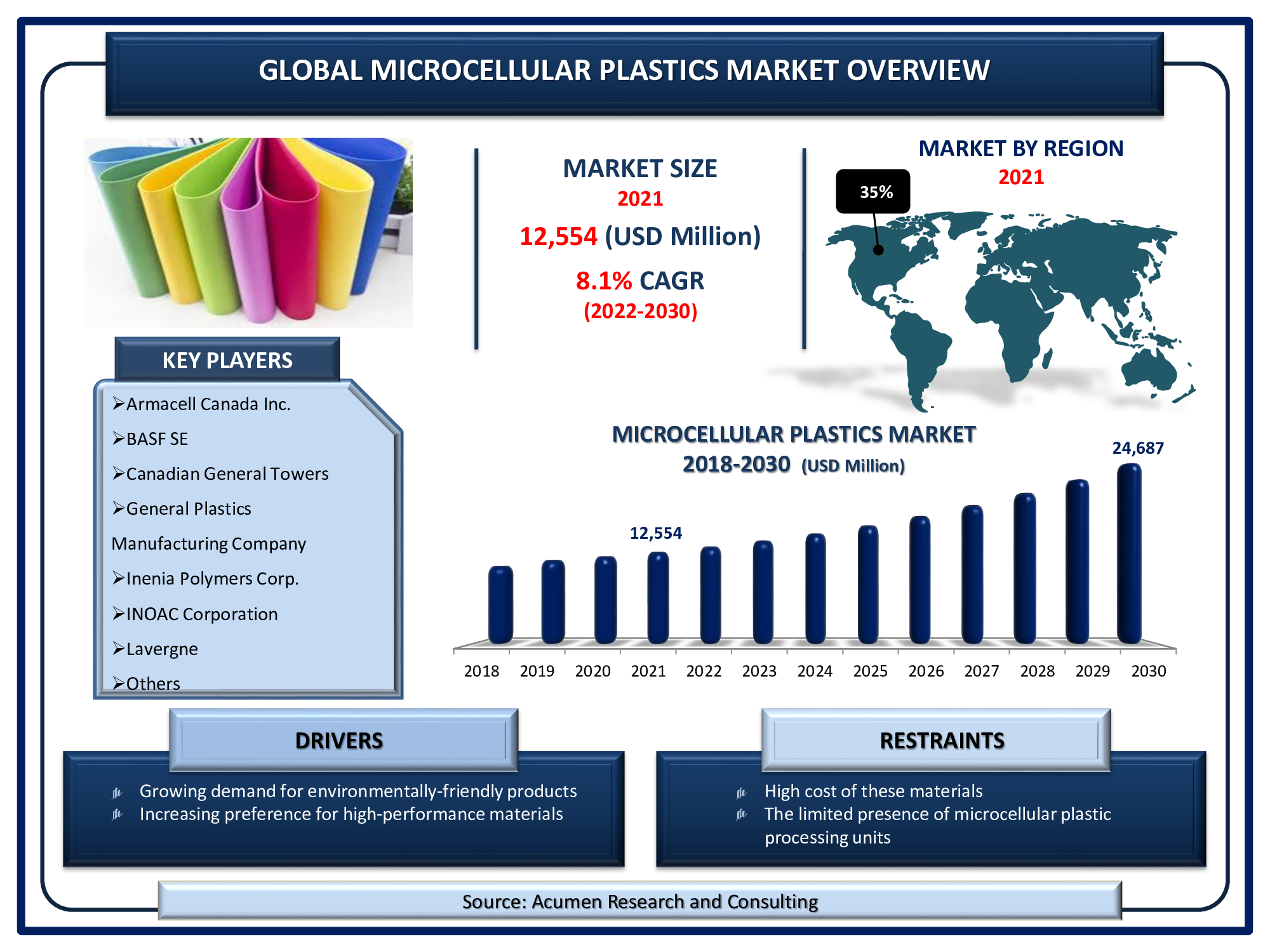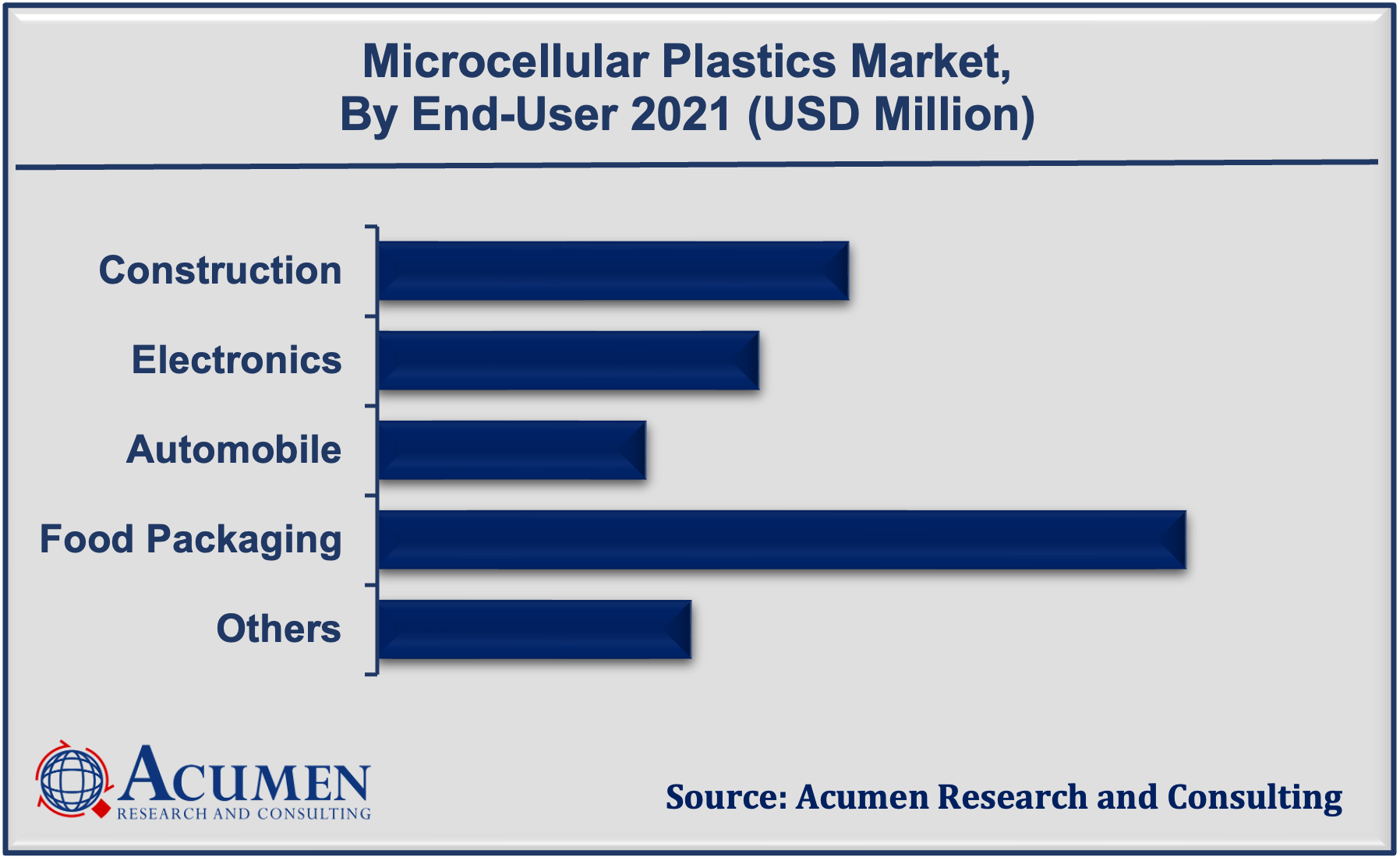Microcellular Plastics Market Size - Global Industry Share, Analysis, Trends and Forecast 2022 - 2030
Published :
Report ID:
Pages :
Format :
Microcellular Plastics Market Size - Global Industry Share, Analysis, Trends and Forecast 2022 - 2030
Report Coverage
- Industry Dynamics
- Market Size and Forecast Data
- Segment Analysis
- Competitive Landscape
- Regional Analysis with a Niche Focus on Country-Level Data
- High Level Analysis - Porter's, PESTEL, Value Chain, etc.
- Company Profiles of Key Players
- Option to Customize the Report As Per Your Specific Need
Request Sample Report
The Global Microcellular Plastics Market Size accounted for USD 12,554 Million in 2021 and is projected to reach USD 24,687 Million by 2030.

According to our microcellular plastics industry analysis, rapid urbanization is the primary factor fueling market growth. The growing interest in high-performance materials among widespread industries is one of the prominent microcellular plastics market trends driving the industry. Microcellular plastics are a unique material with small cell size (10 microns) and high cell density (10 billion cells per cc). These plastics were developed by researchers at the Massachusetts Institute of Technology (MIT). Microcellular plastics are popular for their enhanced physical, thermal, and electrical properties. In addition, these plastics are proven to significantly reduce material costs and consumption. Furthermore, added benefits such as higher strength-to-weight ratio, improved thermal and electrical insulation properties, reduction in pollutants, and better thermal stability have created awareness among consumers and manufacturers to utilize microcellular plastics. As a result, our global microcellular plastics market forecast says that the industry is expected to attain CAGR of 8.1% throughout the forecast timeframe from 2022 to 2030.
Microcellular Plastics Market Drivers
- Rapid urbanization across the world
- Growing demand for environmentally friendly products
- Increasing preference for high-performance materials
- Growing consumption of plastic throughout the globe
Microcellular Plastics Market Restraints
- High cost of these materials
- The limited presence of microcellular plastic processing units
Microcellular Plastics Market Opportunities
- Increasing building and construction activities
- Robust demand for lightweight automobiles
Microcellular Plastics Market Report Coverage
| Market | Microcellular Plastics Market |
| Microcellular Plastics Market Size 2021 | USD 12,554 Million |
| Microcellular Plastics Market Forecast 2030 | USD 24,687 Million |
| Microcellular Plastics Market CAGR | 8.1% During 2022 - 2030 |
| Analysis Period | 2018 - 2030 |
| Base Year | 2021 |
| Forecast Data | 2022 - 2030 |
| Segments Covered | By Type, By Application, By End-User, And By Region |
| Regional Scope | North America, Europe, Asia Pacific, Latin America, and Middle East & Africa |
| Key Companies Profiled | Armacell Canada Inc., BASF SE, Canadian General Towers, General Plastics Manufacturing Company, Inenia Polymers Corp., INOAC Corporation, Lavergne Performance Compounds, Mearthane Products, Rogers Corporation, Saint-Gobain, and Trexel, Inc. |
| Report Coverage |
Market Trends, Drivers, Restraints, Competitive Analysis, Player Profiling, Regulation Analysis |
Microcellular Plastics Market Dynamics
The surging preference for environmentally-friendly products is the primary factor boosting the global microcellular plastics market revenue. Microcellular plastics are manufactured using environmentally safe gases such as nitrogen and carbon dioxide rather than hydrocarbons, hydrochlorofluorocarbons, or chlorofluorocarbons making them an appealing alternative to current plastic foam processes. The increasing consumption of plastic throughout the world is another factor that is driving the microcellular plastics market value. For instance, global demand for plastics has quadrupled in the last four decades and is expected to rise further in the future, worsening the effects on the environment and human health. Plastic production accounted for 96% of the particulate matter health footprint, according to Down To Earth statistics. Half of this was likened to coal combustion. This was caused by an increase in plastic production in coal-based countries. As a result, because of the increased use of coal, the researchers discovered that the impact of plastic on the environment and health is higher than previously thought. Additionally, the rising demand for high-performance materials is expected to fuel the market demand in the coming years.
However, the high manufacturing cost of these materials might act as a hindrance to market growth. Moreover, microcellular plastics have a limited range of applicability as compared to standard plastics due to their porous nature. This factor is also likely to plummet the market growth in the coming years. Furthermore, ongoing research & development activities in the microcellular plastic industry are anticipated to open new frontiers for the market growth during the projected years from 2022 to 2030.
Microcellular Plastics Market Segmentation
The global microcellular plastics market is segmented based on type, application, end-user, and region.
Microcellular Plastics Market By Type
- Polystyrene (PS)
- Polyvinyl Chloride (PVC)
- Polycarbonate (PC)
- Polyethylene Terephthalate (PET)
Based on our analysis,the polyvinyl chloride (PVC) segment achieved a noteworthy microcellular plastics market share in 2021. Polyvinyl chloride (PVC) is a thermoplastic polymer that has permeated many aspects of life due to its widespread use and has become a universal polymer. PVC, or polyvinyl chloride, is one of the most commonly used plastics in building and construction. It is used as a modern alternative to traditional materials such as wood, metal, rubber, and glass in drinking water and waste water pipes, flooring and roofing foils, window frames, wall coverings, cables, and many other applications. These products are frequently lighter, less expensive, and provide numerous performance benefits.
Microcellular Plastics Market By Application
- Home Decorative
- Toys
- Aircraft
- Others
Out of these, the aircraft segment gathered a sizeable microcellular plastics market share in 2021 due to its high strength-to-weight ratio, a significant increase in toughness, the surge in thermal stability, and reduction of material costs up to 95%. On the other hand, the growing demand for toys and home decorative products is expected to grow with a considerable CAGR during the forecasted timeframe from 2022 to 2030.
Microcellular Plastics Market By End-User
- Construction
- Electronics
- Automobile
- Food Packaging
- Others

In 2021, the food packaging sub-segment held a significant share in the entire end-user segment. Plastic consumption in the electronics sector has increased significantly in recent years. Microcellular plastics are also used in construction scaffolding. Scaffolding is a temporary structure created to accommodate the work crew during construction. As a result, the rapidly expanding construction market is expected to drive demand for microcellular plastics throughout the projected timeline. Because of the global growth of the automotive industry, transportation is expected to be another primary factor influencing the microcellular plastic market.
Microcellular Plastics Market Regional Overview
North America
- U.S.
- Canada
Europe
- U.K.
- Germany
- France
- Spain
- Rest of Europe
Latin America
- Mexico
- Brazil
- Rest of Latin America
Asia-Pacific
- India
- Japan
- China
- Australia
- South Korea
- Rest of Asia-Pacific
The Middle East & Africa (MEA)
- Gulf Cooperation Council (GCC)
- South Africa
- Rest of the Middle East & Africa
Increased Research & Development Activities In North America Fuels The Regional Market Growth
According to the microcellular plastics regional outlook, North America gathered a substantial amount of share in 2021 due to the ongoing research & development activities, surging demand for high-performance microparticles, and the presence of many key players in the region. On the other hand, Asia-Pacific has emerged as the fastest-growing region during the projected timeframe from 2022 to 2030. The high growth in the region is attributed to the increasing demand for microcellular plastics in medical, construction, and food packaging industry.
Microcellular Plastics Market Players
Some of the top microcellular plastics companies offered in the professional report include Armacell Canada Inc., BASF SE, Canadian General Towers, General Plastics Manufacturing Company, Inenia Polymers Corp., INOAC Corporation, Lavergne Performance Compounds, Mearthane Products, Rogers Corporation, Saint-Gobain, and Trexel, Inc.
Frequently Asked Questions
How much was the estimated market size of global microcellular plastics market in 2021?
The global microcellular plastics market size accounted for USD 12,554 Million in 2021.
What will be the projected CAGR for global microcellular plastics market during forecast period of 2022 to 2030?
The projected CAGR microcellular plastics market during the analysis period of 2022 to 2030 is 8.1%.
Which are the prominent competitors operating in the market?
The prominent players of the global Armacell Canada Inc., BASF SE, Canadian General Towers, General Plastics Manufacturing Company, Inenia Polymers Corp., INOAC Corporation, Lavergne Performance Compounds, Mearthane Products, Rogers Corporation, Saint-Gobain, and Trexel, Inc.
Which region held the dominating position in the global microcellular plastics market?
North America held the dominating microcellular plastics during the analysis period of 2022 to 2030.
Which region exhibited the fastest growing CAGR for the forecast period of 2022 to 2030?
Asia-Pacific region exhibited fastest growing CAGR for microcellular plastics during the analysis period of 2022 to 2030.
What are the current trends and dynamics in the global microcellular plastics market?
Growing demand for environmentally-friendly products, increasing preference for high-performance materials, and growing consumption of plastic throughout the globe drives the growth of global Microcellular Plasticsmarket.
By segment type, which sub-segment held the maximum share?
Based on type, polyvinyl chloride (PVC)segment held the maximum share microcellular plastics market in 2021.


